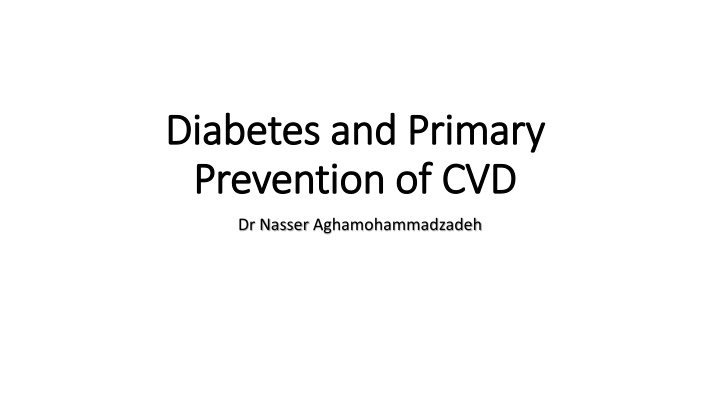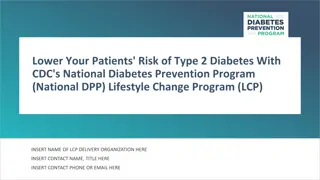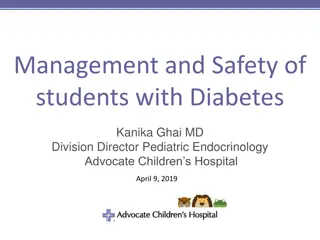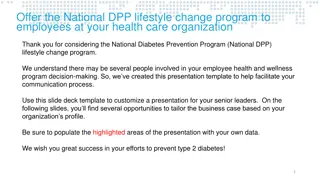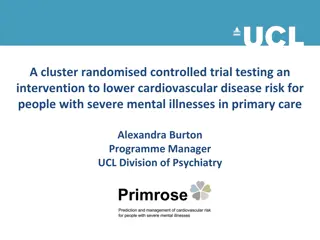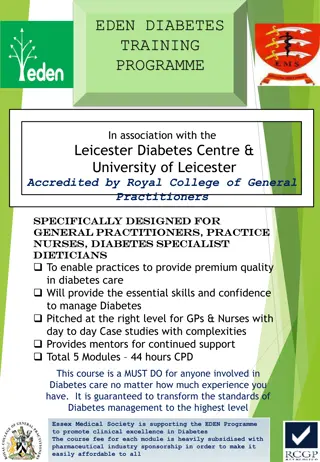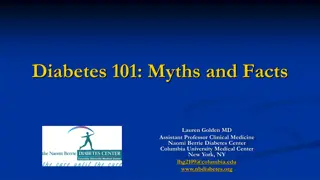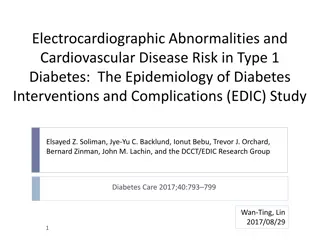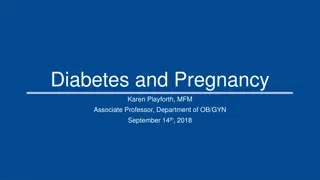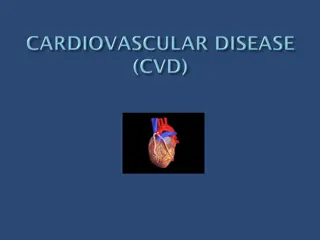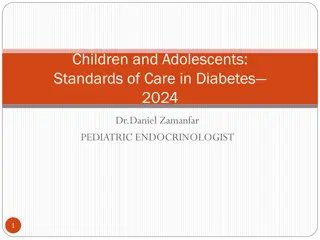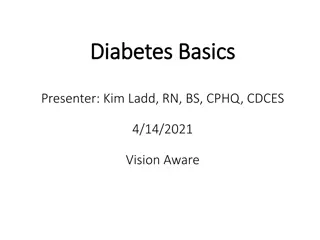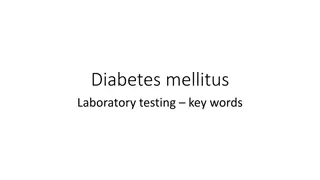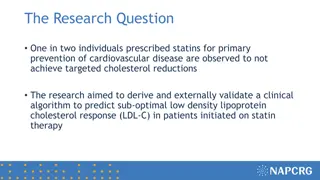Diabetes and Primary Prevention of CVD by Dr. Nasser Aghamohammadzadeh
Comprehensive overview of diabetes classification, diagnosis, prevention, and care standards in 2021, including patient-centered collaborative approaches and risk factor management for vascular disease. Detailed insights on type 1 and type 2 diabetes, gestational diabetes, and strategies for delaying type 2 diabetes.
Download Presentation

Please find below an Image/Link to download the presentation.
The content on the website is provided AS IS for your information and personal use only. It may not be sold, licensed, or shared on other websites without obtaining consent from the author.If you encounter any issues during the download, it is possible that the publisher has removed the file from their server.
You are allowed to download the files provided on this website for personal or commercial use, subject to the condition that they are used lawfully. All files are the property of their respective owners.
The content on the website is provided AS IS for your information and personal use only. It may not be sold, licensed, or shared on other websites without obtaining consent from the author.
E N D
Presentation Transcript
Diabetes and Primary Diabetes and Primary Prevention of CVD Prevention of CVD Dr Nasser Aghamohammadzadeh
Standards of Medical Care Standards of Medical Care in Diabetes 2021 Diabetes 2021 2021 Standards of Medical Care in in Diabetes Standards of Medical Care in Diabetes 2021
CLASSIFICATION AND DIAGNOSIS OF DIABETES Classification Diabetes can be classified into the following general categories: 1. Type 1 diabetes (due to autoimmune -cell destruction, usually leading to absolute insulin deficiency, including latent autoimmune diabetes of adulthood) 2. Type 2 diabetes (due to a progressive loss of -cell insulin secretion frequently on the background of insulin resistance) 3. Specific types of diabetes due to other causes, e.g., monogenic diabetes syndromes (such as neonatal diabetes and maturity-onset diabetes of the young), diseases of the exocrine pancreas (such as cystic fibrosis and pancreatitis), and drug- or chemical-induced diabetes (such as with glucocorticoid use, in the treatment of HIV/AIDS, or after organ transplantation) 4. Gestational diabetes mellitus (diabetes diagnosed in the second or third trimester of pregnancy that was not clearly overt diabetes prior to gestation)
PREVENTION OR DELAY OF TYPE 2 DIABETES Prevention of Vascular Disease and Mortality 3.8 therefore, screening for and treatment of modifiable risk factors for cardiovascular disease are suggested. B Prediabetes is associated with heightened cardiovascular risk;
Section 4. Comprehensive Medical Evaluation and Assessment of Comorbidities
COMPREHENSIVE MEDICAL EVALUATION AND ASSESSMENT OF COMORBIDITIES Patient-centered Collaborative Care 4.1 and strength-based language and active listening; elicits patient preferences and beliefs; and assesses literacy, numeracy, and potential barriers to care should be used to optimize patient health outcomes and health-related quality of life. B A patient-centered communication style that uses person- centered 4.2 multidisciplinary team that may draw from diabetes care and education specialists, primary care providers, subspecialty providers, nurses, dietitians, exercise specialists, pharmacists, dentists, podiatrists, and mental health professionals. E People with diabetes can benefit from a coordinated
COMPREHENSIVE MEDICAL EVALUATION AND ASSESSMENT OF COMORBIDITIES Comprehensive Medical Evaluation and Assessment of Comorbidities: Standards of Medical Care in Diabetes - 2021. Diabetes Care 2021;44(Suppl. 1):S40-S52
COMPREHENSIVE MEDICAL EVALUATION AND ASSESSMENT OF COMORBIDITIES Comprehensive Medical Evaluation 4.3 A complete medical evaluation should be performed at the initial visit to: Confirm the diagnosis and classify diabetes. A Evaluate for diabetes complications and potential comorbid conditions. A Review previous treatment and risk factor control in patients with established diabetes. A Begin patient engagement in the formulation of a care management plan. A Develop a plan for continuing care. A
COMPREHENSIVE MEDICAL EVALUATION AND ASSESSMENT OF COMORBIDITIES Comprehensive Medical Evaluation (continued) 4.4 comprehensive medical evaluation (see Table 4.1). A A follow-up visit should include most components of the initial 4.5 status, diabetes complications, cardiovascular risk (see THE RISK CALCULATOR, Section 10 Cardiovascular Disease and Risk Management, https://doi.org/10.2337/dc21-010), hypoglycemia risk, and shared decision-making to set therapeutic goals. B Ongoing management should be guided by the assessment of overall health
COMPREHENSIVE MEDICAL EVALUATION AND ASSESSMENT OF COMORBIDITIES Comprehensive Medical Evaluation and Assessment of Comorbidities: Standards of Medical Care in Diabetes - 2021. Diabetes Care 2021;44(Suppl. 1):S40-S52
COMPREHENSIVE MEDICAL EVALUATION AND ASSESSMENT OF COMORBIDITIES Comprehensive Medical Evaluation and Assessment of Comorbidities: Standards of Medical Care in Diabetes - 2021. Diabetes Care 2021;44(Suppl. 1):S40-S52
COMPREHENSIVE MEDICAL EVALUATION AND ASSESSMENT OF COMORBIDITIES Comprehensive Medical Evaluation and Assessment of Comorbidities: Standards of Medical Care in Diabetes - 2021. Diabetes Care 2021;44(Suppl. 1):S40-S52
COMPREHENSIVE MEDICAL EVALUATION AND ASSESSMENT OF COMORBIDITIES Comprehensive Medical Evaluation and Assessment of Comorbidities: Standards of Medical Care in Diabetes - 2021. Diabetes Care 2021;44(Suppl. 1):S40-S52
COMPREHENSIVE MEDICAL EVALUATION AND ASSESSMENT OF COMORBIDITIES Comprehensive Medical Evaluation and Assessment of Comorbidities: Standards of Medical Care in Diabetes - 2021. Diabetes Care 2021;44(Suppl. 1):S40-S52
FACILITATING BEHAVIOR CHANGE AND WELL-BEING TO IMPROVE HEALTH OUTCOMES Physical Activity 5.26 engage in 60 min/day or more of moderate- or vigorous-intensity aerobic activity, with vigorous muscle-strengthening and bone-strengthening activities at least 3 days/week. C Children and adolescents with type 1 or type 2 diabetes or prediabetes should 5.27 more of moderate to vigorous-intensity aerobic activity per week, spread over at least 3 days/week, with no more than 2 consecutive days without activity. Shorter durations (minimum 75min/week) of vigorous intensity or interval training may be sufficient for younger and more physically fit individuals. Most adults with type 1 C and type 2 B diabetes should engage in 150 min or
FACILITATING BEHAVIOR CHANGE AND WELL-BEING TO IMPROVE HEALTH OUTCOMES Smoking Cessation: Tobacco & E-cigarettes 5.32 cigarettes. A Advise all patients not to use cigarettes and other tobacco products or e- 5.33 counseling and other forms of treatment as a routine component of diabetes care. A After identification of tobacco or e-cigarette use, include smoking cessation 5.34 in need. B Address smoking cessation as part of diabetes education programs for those
Glycemic targets Glycemic Targets: Standards of Medical Care in Diabetes - 2021. Diabetes Care 2021;44(Suppl. 1):S73-S84
Section 9. Pharmacologic Approaches to Glycemic Treatment
PHARMACOLOGIC APPROACHES TO GLYCEMIC TREATMENT Pharmacologic Therapy for Type 2 Diabetes 9.4 type 2 diabetes. A Metformin is the preferred initial pharmacologic agent for the treatment of 9.5 not contraindicated; other agents, including insulin, should be added to metformin. A Once initiated, metformin should be continued as long as it is tolerated and 9.6 initiation to extend the time to treatment failure. A Early combination therapy can be considered in some patients at treatment 9.7 ongoing catabolism (weight loss), if symptoms of hyperglycemia are present, or when A1C levels (>10% [86 mmol/mol]) or blood glucose levels ( 300 mg/dL [16.7 mmol/L]) are very high. E The early introduction of insulin should be considered if there is evidence of
PHARMACOLOGIC APPROACHES TO GLYCEMIC TREATMENT Pharmacologic Therapy for Type 2 Diabetes (continued) 9.8 A patient-centered approach should be used to guide the choice of pharmacologic agents. Considerations include effect on cardiovascular and renal comorbidities, efficacy, hypoglycemia risk, impact on weight, cost, risk for side effects, and patient preferences(Table 9.1 and Figure 9.1). E 9.9 cardiovascular disease or indicators of high risk, established kidney disease, or heart failure, a sodium glucose cotransporter 2 inhibitor or glucagon-like peptide 1 receptor agonist with demonstrated cardiovascular disease benefit (Table 9.1, Table 10.3B, Table 10.3C) is recommended as part of the glucose-lowering regimen independent of A1C and in consideration of patient-specific factors (Fig. 9.1 and Section 10).A Among patients with type 2 diabetes who have established atherosclerotic
PHARMACOLOGIC APPROACHES TO GLYCEMIC TREATMENT Pharmacologic Therapy for Type 2 Diabetes (continued) 9.10 In patients with type 2 diabetes, a glucagon-like peptide 1 receptor agonist is preferred to insulin when possible. A 9.11 Recommendation for treatment intensification for patients not meeting treatment goals should not be delayed. A 9.12 The medication regimen and medication-taking behavior should be reevaluated at regular intervals (every 3 6 months) and adjusted as needed to incorporate specific factors that impact choice of treatment (Fig. 4.1 and Table 9.1). E
PHARMACOLOGIC APPROACHES TO GLYCEMIC TREATMENT Glucose-lowering Medication in Type 2 Diabetes: 2021 ADA Professional Practice Committee (PPC) adaptation of Davies et al. and Buse et al. Pharmacologic Approaches to Glycemic Management: Standards of Medical Care in Diabetes -
Section 10. Cardiovascular Disease and Risk Management
CARDIOVASCULAR DISEASE AND RISK MANAGEMENT Screening and Diagnosis 10.1 found to have elevated blood pressure ( 140/90 mmHg) should have blood pressure confirmed using multiple readings, including measurements on a separate day, to diagnose hypertension. B Blood pressure should be measured at every routine clinical visit. Patients 10.2 at home. B All hypertensive patients with diabetes should monitor their blood pressure
CARDIOVASCULAR DISEASE AND RISK MANAGEMENT Treatment Goals 10.3 individualized through a shared decision-making process that addresses cardiovascular risk, potential adverse effects of antihypertensive medications, and patient preferences. C For patients with diabetes and hypertension, blood pressure targets should be 10.4 (existing atherosclerotic cardiovascular disease [ASCVD] or 10-year ASCVD risk 15%), a blood pressure target of, 130/80 mmHg may be appropriate, if it can be safely attained. C For individuals with diabetes and hypertension at higher cardiovascular risk 10.5 cardiovascular disease (10-year atherosclerotic cardiovascular disease risk <15%), treat to a blood pressure target of <140/90 mmHg. A For individuals with diabetes and hypertension at lower risk for
CARDIOVASCULAR DISEASE AND RISK MANAGEMENT Recommendations for the Treatment of Confirmed Hypertension in People with Diabetes (1 of 2) Cardiovascular Disease and Risk Management: Standards of Medical Care in Diabetes - 2021. Diabetes Care 2021;44(Suppl. 1):S111-S150
CARDIOVASCULAR DISEASE AND RISK MANAGEMENT Recommendations for the Treatment of Confirmed Hypertension in People with Diabetes (2 of 2) Cardiovascular Disease and Risk Management: Standards of Medical Care in Diabetes - 2021. Diabetes Care 2021;44(Suppl. 1):S111-S150
CARDIOVASCULAR DISEASE AND RISK MANAGEMENT Lipid Management Lifestyle Intervention 10.15 Lifestyle modification focusing on weight loss (if indicated); application of a Mediterranean style or Dietary Approaches to Stop Hypertension (DASH) eating pattern; reduction of saturated fat and trans fat; increase of dietary acids, viscous fiber, and plant stanols/sterols intake; and increased physical activity should be recommended to improve the lipid profile and reduce the risk of developing atherosclerotic cardiovascular disease in patients with diabetes. A n-3 fatty 10.16 Intensify lifestyle therapy and optimize glycemic control for patients with elevated triglyceride levels ( 150 mg/dL [1.7 mmol/L]) and/or low HDL cholesterol (<40 mg/dL [1.0 mmol/L] for men, <50 mg/dL [1.3 mmol/L] for women).C
CARDIOVASCULAR DISEASE AND RISK MANAGEMENT Lipid Management Ongoing Therapy and Monitoring with Lipid Panel 10.17 In adults not taking statins or other lipid-lowering therapy, it is reasonable to obtain a lipid profile at the time of diabetes diagnosis, at an initial medical evaluation, and every 5 years thereafter if under the age of 40 years, or more frequently if indicated. E 10.18 Obtain a lipid profile at initiation of statins or other lipid lowering therapy, 4 12 weeks after initiation or a change in dose, and annually thereafter as it may help to monitor the response to therapy and inform medication adherence. E
CARDIOVASCULAR DISEASE AND RISK MANAGEMENT Statin Treatment Primary Prevention 10.19 For patients with diabetes aged 40 75 years without atherosclerotic cardiovascular disease, use moderate-intensity statin therapy in addition to lifestyle therapy. A 10.20 For patients with diabetes aged 20 39 years with additional atherosclerotic cardiovascular disease risk factors, it maybe reasonable to initiate statin therapy in addition to lifestyle therapy. C 10.21 In patients with diabetes at higher risk, especially those with multiple atherosclerotic cardiovascular disease risk factors or aged 50 70 years, it is reasonable to use high-intensity statin therapy. B 10.22 In adults with diabetes and 10-year ASCVD risk of 20% or higher, it may be reasonable to add ezetimibe to maximally tolerated statin therapy to reduce LDL cholesterol levels by 50% or more. C
CARDIOVASCULAR DISEASE AND RISK MANAGEMENT Statin Treatment Secondary Prevention 10.23 For patients of all ages with diabetes and atherosclerotic cardiovascular disease, high intensity statin therapy should be added to lifestyle therapy. A 10.24 For patients with diabetes and atherosclerotic cardiovascular disease considered very high risk using specific criteria, if LDL cholesterol is 70 mg/dL on maximally tolerated statin dose, consider adding additional LDL-lowering therapy (such as ezetimibe or PCSK9 inhibitor). A Ezetimibe may be preferred due to lower cost. 10.25 For patients who do not tolerate the intended intensity, the maximally tolerated statin dose should be used. E
CARDIOVASCULAR DISEASE AND RISK MANAGEMENT Statin Treatment Secondary Prevention (continued) 10.26 In adults with diabetes aged >75 years already on statin therapy, it is reasonable to continue statin treatment. B 10.27 In adults with diabetes aged >75 years, it may be reasonable to initiate statin therapy after discussion of potential benefits and risks. C 10.28 Statin therapy is contraindicated in pregnancy. B
CARDIOVASCULAR DISEASE AND RISK MANAGEMENT Cardiovascular Disease and Risk Management: Standards of Medical Care in Diabetes - 2021. Diabetes Care 2021;44(Suppl. 1):S111-S150
CARDIOVASCULAR DISEASE AND RISK MANAGEMENT Other Combination Therapy 10.32 Statin plus fibrate combination therapy has not been shown to improve atherosclerotic cardiovascular disease outcomes and is generally not recommended. A 10.33 Statin plus niacin combination therapy has not been shown to provide additional cardiovascular benefit above statin therapy alone, may increase the risk of stroke with additional side effects, and is generally not recommended. A
CARDIOVASCULAR DISEASE AND RISK MANAGEMENT Antiplatelet Agents 10.34 Use aspirin therapy (75 162 mg/day) as a secondary prevention strategy in those with diabetes and a history of atherosclerotic cardiovascular disease. A 10.35 For patients with atherosclerotic cardiovascular disease and documented aspirin allergy, clopidogrel (75 mg/day) should be used. B 10.36 Dual antiplatelet therapy (with low-dose aspirin and a P2Y12 inhibitor) is reasonable for a year after an acute coronary syndrome and may have benefits beyond this period. A 10.37 Long-term treatment with dual antiplatelet therapy should be considered for patients with prior coronary intervention, high ischemic risk, and low bleeding risk to prevent major adverse cardiovascular events. A
CARDIOVASCULAR DISEASE AND RISK MANAGEMENT Antiplatelet Agents (continued) 10.38 Combination therapy with aspirin plus low-dose rivaroxaban should be considered for patients with stable coronary and/or peripheral artery disease and low bleeding risk to prevent major adverse limb and cardiovascular events. A 10.39 Aspirin therapy (75 162 mg/day) may be considered as a primary prevention strategy in those with diabetes who are at increased cardiovascular risk, after a comprehensive discussion with the patient on the benefits versus the comparable increased risk of bleeding. A
CARDIOVASCULAR DISEASE AND RISK MANAGEMENT Cardiovascular Disease Screening 10.40 In asymptomatic patients, routine screening for coronary artery disease is not recommended as it does not improve outcomes as long as atherosclerotic cardiovascular disease risk factors are treated. A 10.41 Consider investigations for coronary artery disease in the presence of any of the following : atypical cardiac symptoms (e.g., unexplained dyspnea, chest discomfort); signs or symptoms of associated vascular disease including carotid bruits, transient ischemic attack, stroke, claudication, or peripheral arterial disease; or electrocardiogram abnormalities (e.g., Q waves).E
CARDIOVASCULAR DISEASE AND RISK MANAGEMENT Cardiovascular Disease Treatment 10.42a In patients with type 2 diabetes and established atherosclerotic cardiovascular disease, multiple atherosclerotic cardiovascular disease risk factors, or diabetic kidney disease, a sodium glucose cotransporter 2 inhibitor with demonstrated cardiovascular benefit is recommended to reduce the risk of major adverse cardiovascular events and/or heart failure hospitalization. A 10.42b In patients with type 2 diabetes and established atherosclerotic cardiovascular disease or multiple risk factors for atherosclerotic cardiovascular disease, a glucagon-like peptide 1 receptor agonist with demonstrated cardiovascular benefit is recommended to reduce the risk of major adverse cardiovascular events. A
CARDIOVASCULAR DISEASE AND RISK MANAGEMENT Cardiovascular Disease Treatment (continued) 10.43 In patients with type 2 diabetes and established heart failure with reduced ejection fraction, a sodium glucose cotransporter 2 inhibitor with proven benefit in this patient population is recommended to reduce risk of worsening heart failure and cardiovascular death. A 10.44 In patients with known atherosclerotic cardiovascular disease, particularly coronary artery disease, ACE inhibitor or angiotensin receptor blocker therapy is recommended to reduce the risk of cardiovascular events. A 10.45 In patients with prior myocardial infarction, b-blockers should be continued for 3 years after the event. A
CARDIOVASCULAR DISEASE AND RISK MANAGEMENT Cardiovascular Disease Treatment (continued) 10.46 Treatment of patients with heart failure with reduced ejection fraction should include a b-blocker with proven cardiovascular outcomes benefit, unless otherwise contraindicated. A 10.47 In patients with type 2 diabetes with stable heart failure, metformin may be continued for glucose lowering if estimated glomerular filtration rate remains 30 mL/min/1.73m2 but should be avoided in unstable or hospitalized patients with heart failure. B
